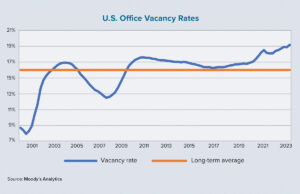The American mall is making a resurgence of sorts. The mall concept, often thought to be on the path to extinction, saw positive sales growth in 2022 and may see even better growth in 2023, according to Green Street, a commercial real estate analytics and intelligence firm with offices in Southern California, New York City and London.
Even with the recent good news, however, Green Street still expects about 35% of U.S. malls to fail in the next 20 years. Emily Arft, a Green Street senior associate for retail research, recently spoke with Scotsman Guide about the health of the nation’s malls and their outlook for the remainder of this year.
“We are a little bit concerned about the first half of the year. That will be the biggest pinch from a consumer-spending perspective.”
What is your overview on the state of malls in America right now?
Based on the third-quarter (2022) results, we are fairly positive about how the malls performed last year. The retail sales were healthy despite the headwinds of inflation and economic uncertainty. However, fourth-quarter foot traffic was not as strong. We estimate that foot traffic for the high-end A-level malls was down about 5% and B-level malls were down about 10%. That is in line with what we would expect because of the demand for luxury products.
Were there any results last year that surprised you?
Sales have definitely been a surprise for us. We’re forecasting mall sales to be up about 10% for the full year of 2022. That is well above our initial estimates of a 2% to 5% growth range. So, the stores have positively surprised on the sales front, quarter after quarter, throughout the years. Occupancy has also been really, really strong. That improvement really has to do with the quality of the tenants during the pandemic.
Are we done with the mall shakeout or do you expect the number of malls to continue declining?
Currently there are about 1,000 malls in the United States, which is more than the market can support. In recent years, we’ve seen about 15 to 20 malls close annually across the country. We think that level of consolidation will continue with about 15 to 20 closing each year. So, we expect 35% of malls to go away in the next 20 years.
How have the surviving malls changed in recent years?
I would really say the tenant mix has improved. Many malls were suffering from having weak tenants. Part of the pandemic fallout was to get rid of many of these weaker tenants. We’ve seen a resurgence in the brick-and-mortar space as retailers are connecting with their customers. Retailers who are smart are reinvigorating the space.
We are also seeing the diversifying of the retailers. In the past, malls were very concentrated with apparel retailers. But that was not enough. They have changed as the mix of stores has diversified. There are fewer apparel and anchor stores, and a greater number of pop-up boutique stores.
How are malls reinventing themselves?
We are seeing a greater push to a mixed-use concept, and a redeveloping of the mall space is very prominent. The problem is it takes years, maybe even a decade, to execute a proper mixed-used concept. So, what we are seeing near term are malls finding new uses for old spaces, such as taking anchor-store boxes and turning them into hospitals or some sort of medical office. They also may turn some parking areas into green spaces, such as grassy areas that can be entertainment centers or places where they can offer concerts.
In which areas of the mall sector are you seeing strength?
Areas of strength are the luxury categories. The luxury retailers have always kept their store numbers very low, very exclusive. But we are seeing that they have had such great success in their existing brick-and mortar footprints that they are looking to expand. We are also seeing that retailers who were born online are now trying to expand their brick-and-mortar footprints to be closer to the consumers.
What are your predictions for the rest of this year?
We are still fairly confident that the fundamentals will hold firm, even if there is a short recession. Granted, if it’s a severe recession, then there will be a squeeze across every property sector. We are still fairly confident that we will see positive growth by the end of 2023. We are a little bit concerned about the first half of the year. That will be the biggest pinch from a consumer-spending perspective. So, if retailers can get through the first half of the year and we have more of a soft landing with inflation and interest rates, then the back half of the year should be pretty positive in the sector. ●






